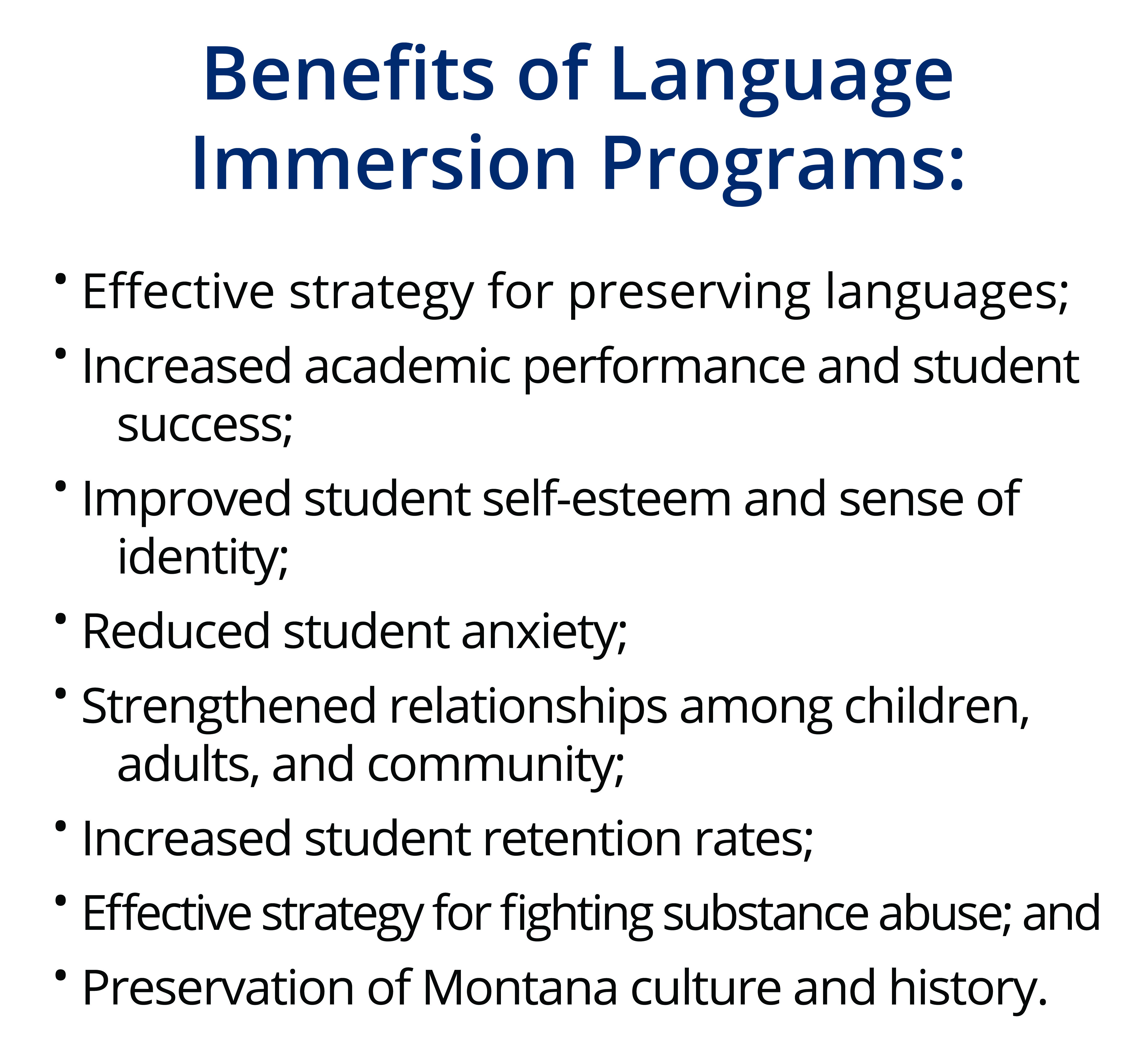Across the nation, tribal languages are vanishing at an alarming rate, taking with them a vital piece of culture and knowledge. The novel coronavirus pandemic presents a new threat to language preservation efforts. Elders, who are a vulnerable population to the virus, help to keep tribal languages alive. While the Montana Legislature has taken steps to preserve and promote tribal languages in the state, the Legislature should make funding for the Montana Indian Language Preservation Program (MILP) and language immersion programs permanent, rather than one-time-only. Permanent funding creates certainty and helps funding recipients develop sustaining programs. These programs are an important step forward in improving student outcomes, strengthening communities, and preserving culture, language, and history in Montana.
In 2013, the Montana Legislature established the Montana Indian Language Preservation Pilot Program, providing $2 million in one-time-only funding to support language preservation efforts by tribal governments.[1] Since then, the Legislature has funded the program on a one-time-only basis, with $1.5 million most recently in 2019.[2]

In 2015, the Legislature passed the Cultural Integrity Commitment Act (Senate Bill 272) to encourage school districts to create language immersion programs on their campuses. The act provided a one-time-only appropriation of $45,000 through the 2017 biennium for Indian language immersion programs of school districts on or near reservations or for those with at least one school that has an American Indian student enrollment of at least 10 percent.[3] The program made Montana the first state after Hawaii to fund tribal language immersion in public schools.[4]
In 2019, the Legislature failed to pass House Bill 371, which would have created a permanent funding source for language preservation programs at a level of $2 million per biennium.[5] Without further action by the Legislature, funding for language preservation programs will end in 2021.
These programs have helped curb the trend in tribal language loss by spurring the creation of language education courses, dictionaries, sound books, and Montana tribal language apps, as well as increasing school districts’ capacity. As a result, all Montanans now have greater access to tribal languages. To continue to build on the successes of this program and curb further loss of tribal languages, the Legislature should permanently and adequately invest in MILP in the 2021 legislative session.
Because of past federal policies and practices, tribal languages are disappearing. Historically, many people held the idea that tribal languages hindered American Indian assimilation. This led to policies that banned tribal languages in school settings, contributing to language loss today.[6]
Of the more than 300 tribal languages once spoken in the United States, only 175 remain. If no action is taken, experts estimate that no more than 20 will remain by 2050.[7] Montana is home to 12 of these languages.[8] Of those, Assiniboine, Gros Ventre, and Montana Salish are critically endangered, meaning that the youngest speakers are elders and that they speak the language partially and infrequently.[9] Despite having a large number of tribal language speakers relative to other tribal nations, the share of citizens of the Crow Tribe of Indians who speak the language fluently has decreased from about 85 percent 60 years ago to about 30 percent today. The decline has been especially sharp among young speakers.[10] Languages that are not spoken by children are at great risk of becoming extinct, or of having no remaining speakers.[11] Unlike speakers of “world” languages, such as Spanish and French, who can be found around the world, speakers of tribal languages tend to live on tribal homelands, meaning shrinking communities of speakers are not replenished.[12] That means that tribal languages are likely lost forever when no speakers remain on tribal homelands.
When communities and schools include tribal languages as part of an academic curriculum, American Indian students benefit in a number of ways, including improved academic success, increased self-esteem and self-worth, a greater sense of cultural identity and belonging, and strengthened relationships.
Many students in Montana stand to benefit from language immersion programs. American Indian students make up about 11 percent, or 16,128, of public K-12 students in Montana.[13] American Indian students that receive language immersion instruction perform better academically than students who do not receive language immersion instruction and also see greater retention rates.[14],[15] For example, in just its first year, the Blackfeet language immersion program in Browning saw both greater attendance and academic performance among its students.[16]
Language-based curricula and instruction promote a strong sense of cultural identity.[17] This is important for a number of reasons. When schools include tribal language in the curriculum, students tend to have increased self-esteem, experience less anxiety, and show a greater level of self-efficacy.[18] In fact, American Indian youth who have a stronger sense of cultural identity are less likely to fall into drug and alcohol abuse, more likely better able to cope with stress, and less likely to have suicidal thoughts.[19] Given the high suicide rates among American Indian youth in Montana, language preservation could be considered one of the tools used to address the issue.
Language immersion programs impact how students relate to themselves and their environments, in part by offering opportunities that bring family members and members of the community into students’ learning environment.[20] This fosters positive child-adult relationships both inside and outside of the classroom, in addition to strengthening family bonds and building community.[21] This kind of engagement provides students a supportive environment and the opportunity to practice language outside of the classroom, ultimately exposing more members of the community to the language.
Continued investments in language preservation will provide the opportunity for more in-depth work toward preserving these valuable languages and will further strengthen the relationship between the state and tribal nations in Montana.

MBPC is a nonprofit organization focused on providing credible and timely research and analysis on budget, tax, and economic issues that impact low- and moderate-income Montana families.